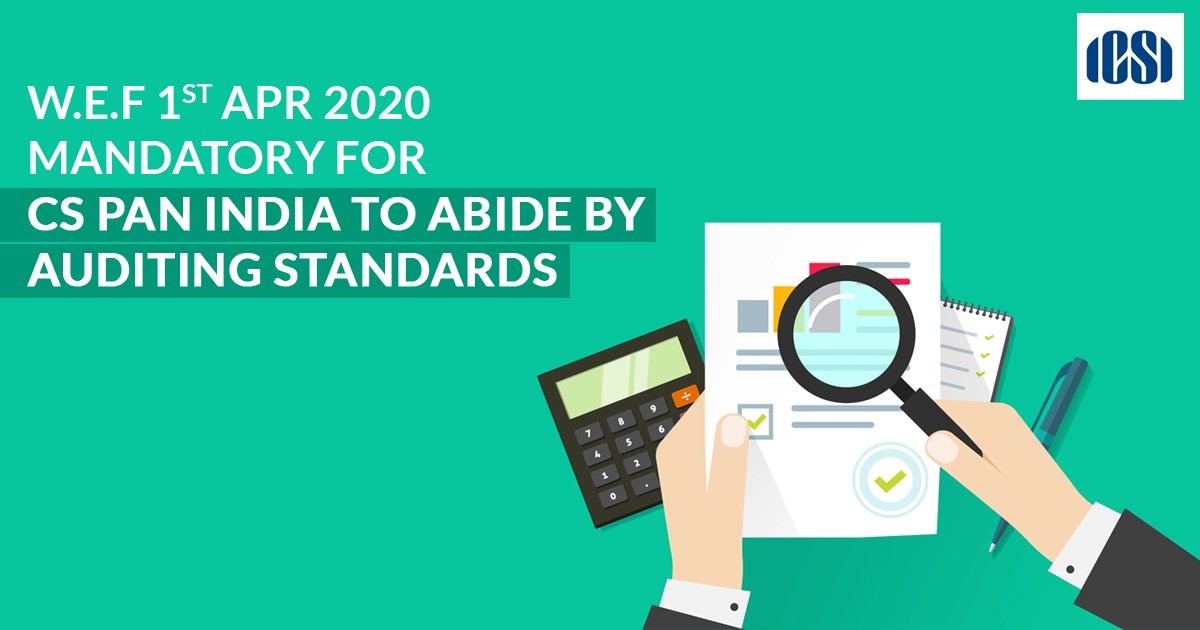
Institute of company secretaries of India (ICSI) is going to mandate the practice of Auditing Standards that were earlier introduced by the institute on a voluntary basis in July 2019. Starting from 1 April 2020, all the audits held in the companies will adhere to these Auditing Standards.
Key Points to be noted:
- Every practicing Company Secretary is required to abide by the auditing standards.
- Practicing CS is allowed to take the audit assignments that are duly considered valid by the Companies Act 2013, Security and Exchange Board of India Act, 1992, or any other related law.
Key Objectives of the Auditing Standards:
i. Enhancement of auditing tools, equipment and techniques.
ii. Updating the laws to make it in-line with the current needs of the company and government.
iii. Establishing a protocol nationwide that will bring in uniformity and professionalism in the audit.
For the norms to be easily understood, Auditing Standards are segregated into four parts:
- Auditing Engagement (CSAS 1)
- The Process of Audit and related Paperwork (CSAS 2)
- Forming of Opinion (CSAS 3)
- Secretarial Audit (CSAS 4)
Eligibility to conduct the Audit is practicing CS certificate and Audit Engagement letter. Any of the above-mentioned documents if missing will restrict the CS from performing the Audit.
Auditing Engagement (CSAS 1)
The auditor must keep in mind the protocols of the Audit Engagement Process set by the authorities while he/she conducts an audit.
- The pre-audit meeting is a must in between the auditor and auditee to discuss several issues and outcomes of the previous audit.
- Rules related to the appointment of the auditor are mentioned in auditing standards that have to be followed at the time of auditor appointment.
- Auditors must have the eligibility certificate that allows him/her to conduct the audit.
- It is an offense if any auditor pays the commission to obtain the audit.
- Auditor must communicate to the previous auditor and gain the information that will help them in the further process.
- After meeting with the previous auditor, the auditor must wait for 7 days before starting with the audit.

Auditor must have:
- MGT-7 duly authenticated
- Certification in MGT 8
- Secretarial Audit u/s 204
Auditors must adhere to the number of audits he can conduct.
- For secretarial audit is 10 per PCS
- Number of Annual Secretarial Compliance Reports is 5
- Conflict of interest with the auditee shall not interrupt as a substantial interest.
- If an auditor is holding 2% paid-up capital or shares worth Rs. 50,000 (whichever is lower),
- auditor indebted to auditee amount upto Rs. 5,00,000, >auditor is working for the auditee for more than 2 years.
Audit Process and Documentation (CSAS 2)
The entire process of Audit is based on planning, execution and documentation. None of these could be skipped in the audit.
Audit Plan – Setting up a roadmap before starting the process is crucial. The perfect audit plan gives all the answers for what, where, who, when and how. Objectives of audit, execution, location and an estimated outline of the audit must be ready.
Risk Assessment– This could be done by identifying the type of industry, organizational structure and legal compliance requirements, market outlook and industry environment.
Auditee’s Information – Auditor has to be aware of the auditee’s nature of business and laws applicable to the business.
Audit Checklist – An audit checklist has to be maintained by the auditor according to which the audit process will flow and compliance requirements will be identified from time to time. An audit checklist is an indispensable need for an audit to effectively work.
Paper Work – Auditors are required to make reports and affix all proofs and documents that are needed. All the audit evidence, work done and outcome of the auditmust duly be stated in the end reports/documents.
Forming of Opinion (CSAS 3) –
Mentioned here are the basic protocols an auditor needs to follow when it comes to evaluating the end results drawn from the audit evidence and give their opinion through a report.
The standards set for audit opinions are:
Misstatement – Noting down if any information is false, misleading, omitted or is mismatched with the auditors’ investigation.
Records – Records include MOA, AOA, minutes, returns, forms, index, registers, etc.
Process of Audit Opinion Forming:
- The Auditor must abide by the following principles
- Principle of Completeness
- Principle of Objectivity
- Principle of Timeliness
- Principle of Contradictory Process
Judgments – While giving the opinion auditor must consider all the clarifications, conflicting interpretations, other party statements, etc. following complete analysis of the reports/statements, the auditor must pen down his/her opinion.
Auditors Responsibility – Auditor in the report must include a section with the heading ‘Auditor’s Responsibility’.
The section will include:
- The proof of audit being conducted as per the basic Auditing Standards.
- The proof the auditor has obtained the reasonable assurance, records prepared and the entire paperwork is free from any false statement.
Format of the Report – The format of the reports will either be given by appointing authorities or specified under audit engagement letter or provided under applicable laws.
Signature in the Reports –
Signature in the reports should include
- name of audit firm
- name of the auditor
- certificate of practicing number
- specified associate or fellow member
The date and place of signing the report shall be mentioned by the auditor in case the report is assigned by two different auditors at different places or different dates.
Conclusion
The audit report is comprehensive of an audit that is prepared by the auditor conducting the audit.
The report includes name, place, nature of the business, scope and objectives of the business, auditor’s opinion and analysis on the position of the company in the market and lot more.
Audit report must be prepared in detail showcasing the state of affairs of the auditee.







